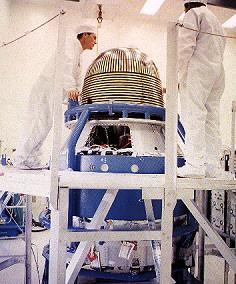 Biosatellite 3 | |
| Manufacturer | General Electric |
|---|---|
| Country of origin | United States |
| Operator | NASA |
| Applications | Bioscience |
| Specifications | |
| Regime | Low Earth orbit |
| Design life | 8-30 days |
| Production | |
| Status | Retired |
| Launched | 3 |
| Maiden launch | Biosatellite 1 14 December 1966 |
| Last launch | Biosatellite 3 29 June 1969 |
NASA's Biosatellite program was a series of three uncrewed artificial satellites to assess the effects of spaceflight, especially radiation and weightlessness, on living organisms. Each was designed to reenter Earth's atmosphere and be recovered at the end of its mission.
Its primary goal was to determine the effects of space environment, particularly weightlessness, on life processes at three levels of organization: basic biochemistry of the cell; structure of growth of cells and tissues; and growth and form of entire plants and animals.[1]
- ^ Rosenthal, Alfred (January 1982). "A record of NASA space missions since 1958". NASA. NASA Technical Reports Server. hdl:2060/19940003358. Retrieved 24 September 2011.